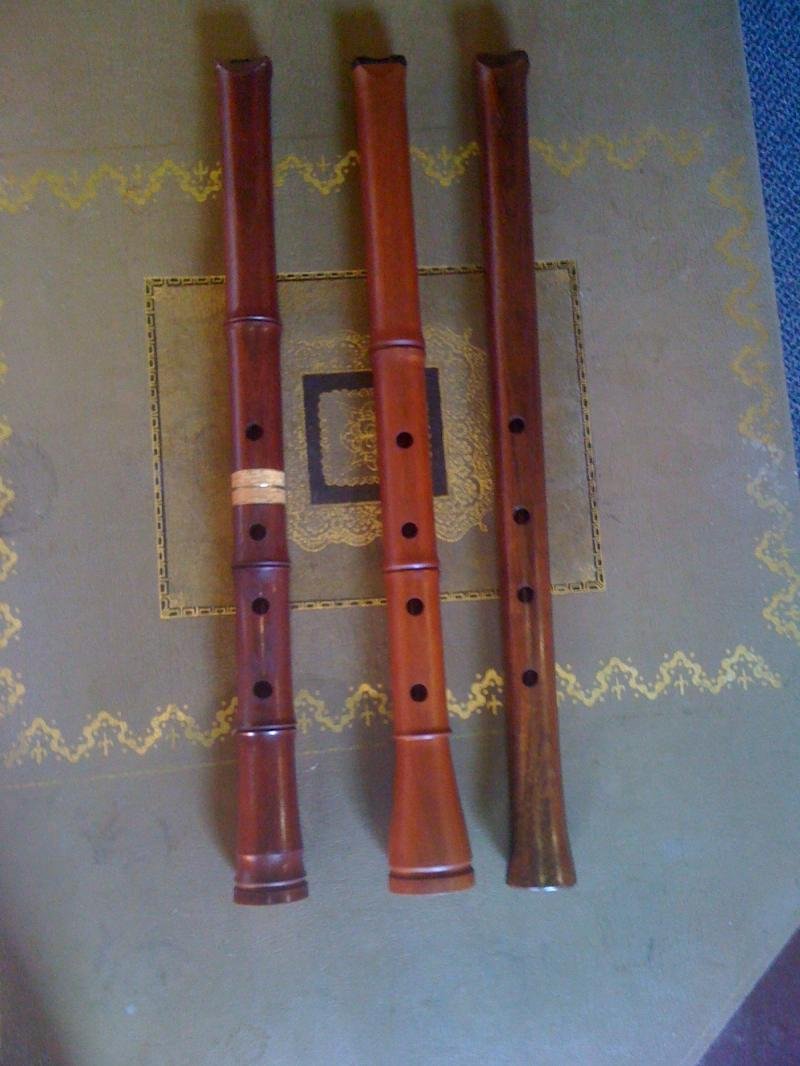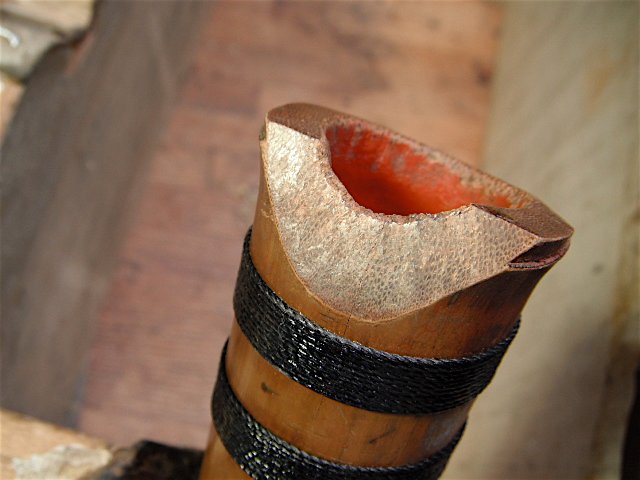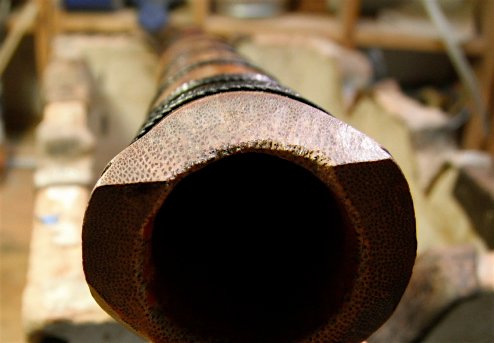3 wooden 1.8's
11
3 wooden 1.8's
I had a rare opportunity to play and compare three handmade wooden 1.8's in the dojo today. L-R David Brown (Australia), Tabi (Australia) and Woodland Voices (USA). Sorry for the mediocre photo quality, iPhone.


Last edited by Brian Tairaku Ritchie on 2011-08-24, 10:46; edited 1 time in total
Happy to report that all three are excellent.
They are pretty similar but there are noticeable differences. First in aesthetics and construction, you can see that in the pics.
D. Brown is wood with a urushi coat in the bore. Tabi is cast bore. Woodland voices is wood with no urushi in the bore as far as I can tell. So......Tabi has the smoothest bore and Woodland Voices has the roughest.
Tabi is brightest in tone, Brown is somewhat mellower and Woodland Voices is the mellowest and most "natural" or "shakuhachi" sounding of the three. This could be function of the bore or maybe because it doesn't have an utaguchi inlay. Maybe Colyn can explain whether he thinks the tone changes when there is no hard utaguchi inlay.
Tabi is the loudest. But they're all plenty loud.
They are pretty similar but there are noticeable differences. First in aesthetics and construction, you can see that in the pics.
D. Brown is wood with a urushi coat in the bore. Tabi is cast bore. Woodland voices is wood with no urushi in the bore as far as I can tell. So......Tabi has the smoothest bore and Woodland Voices has the roughest.
Tabi is brightest in tone, Brown is somewhat mellower and Woodland Voices is the mellowest and most "natural" or "shakuhachi" sounding of the three. This could be function of the bore or maybe because it doesn't have an utaguchi inlay. Maybe Colyn can explain whether he thinks the tone changes when there is no hard utaguchi inlay.
Tabi is the loudest. But they're all plenty loud.
Last edited by Brian Tairaku Ritchie on 2011-08-24, 10:54; edited 2 times in total
Of course there could be differences in geometry, but acoustically speaking it makes sense that the smoothest bore is both brightest and loudest, since it would have the least energy losses at the walls (which are also frequency dependent, with more high than low frequency energy being lost). FWIW if the blowing edge is the same, inlay or no inlay should not make a difference.
"Toby""Toby"FWIW if the blowing edge is the same, inlay or no inlay should not make a difference.
Some people insist an utaguchi inlay makes for a brighter sound.
If it makes no difference then it really makes me wonder why people bother. It's a lot of work and creates another thing that can fail.
Though the words 'no difference' were used in Toby's post, I don't think he was stressing that point. The caveat was 'if the blowing edge is the same'. And could the blowing edge of bamboo be the same as the blowing edge of buffalo horn or acrylic? Since the grain of bamboo is usually exposed when the wall is cut on a bias to accommodate the blowing edge, it makes some kind of sense that those grains, on a microscopic scale might offer more resistance, and thus more turbulence to an airstream than horn or acrylic. It would seem then that the less frictional surface might offer a brighter sound under the same principal that a bore rendered mirror smooth with ji would offer a brighter sound than one without because of the friction issue. As such, I think that according to the prevailing aesthetic, there is every reason to inlay.
I have plenty of great shakuhachi that don't have inlays. And plenty that do! I think they're both nice.
However, you never have structural problems when the flute doesn't have an inlay. But inlays frequently break or fall out. So I recommend to makers to think "why" before using inlays.
Also I think the inlay pushes shakuhachi more in the sonic direction of a silver flute and I like to cultivate a tone that's more raw and natural, usually the flutes without inlay get there.
However, you never have structural problems when the flute doesn't have an inlay. But inlays frequently break or fall out. So I recommend to makers to think "why" before using inlays.
Also I think the inlay pushes shakuhachi more in the sonic direction of a silver flute and I like to cultivate a tone that's more raw and natural, usually the flutes without inlay get there.
I think your observations are totally valid Brian and make sense. I guess what I wanted to say is that just as there are reasons not to opt for an inlay, there are reasons, somewhat in the opposite direction of desired outcome for having one and ultimately it comes down to what you want. But, inlay or not, it does make a difference otherwise this discussion wouldn't be happening. This also proves that the one thing that is equal about blowing edges is that they are all undeniably appreciated for their qualities.
Maybe the makers can make the natural wood/bamboo blowing edge not as sharp as an utaguchi inlay out of other materials? And the sharpness of wood or bamboo may degrade faster then others?
BTW: One more good argument to own more then one flute.
BTW: One more good argument to own more then one flute.
Riley says he thinks the material and even the shape of the utaguchi doesn't make any difference.
I've observed that the flutes I have without utaguchi inlays have a fuzzier and hairier sound sometimes, but that could also be because those makers are usually doing things with the bore and holes that encourage that as well.
I honestly don't know if putting in the utaguchi changes the tone. Whereas with even one coat of urushi I know for a fact that changes the sound.
I've observed that the flutes I have without utaguchi inlays have a fuzzier and hairier sound sometimes, but that could also be because those makers are usually doing things with the bore and holes that encourage that as well.
I honestly don't know if putting in the utaguchi changes the tone. Whereas with even one coat of urushi I know for a fact that changes the sound.
"Brian Tairaku Ritchie""Brian Tairaku Ritchie"
...However, you never have structural problems when the flute doesn't have an inlay. But inlays frequently break or fall out. So I recommend to makers to think "why" before using inlays.
I make flutes with and without. An inlay maintains the sharp blowing edge better than without. Old flutes often sound warmer because the edge has dulled over the years. Here's a mild example:


Also, as Jeff alluded to, that thin natural edge is quite porous and breath moisture causes it to get soggy, especially if the bore is left unlacquered. Even a slightly soggy edge can change the feel of the flute dramatically. However, if the bore and front of the utaguchi are lacquered (sealed), the shape should hold up for a very long time.
Aside from purely functional considerations, my work is also influenced by the idea of practicing fine traditional craftsmanship. Again, as Jeff pointed out, inlays are nice to look at. I like looking at the Mother of Pearl inlay work on a Gibson Hummingbird guitar. And even if I know the guitar works fine without them, running my fingers over them makes the playing experience so much funner.

Last edited by Perry Yung on 2011-09-04, 16:41; edited 1 time in total
The very first flute I ever owned was a extremely rough and cheap 2.4. I never got rid of it... it has historical end emotional value for me. After settling in Canada and meeting my good friend Alcvin Ramos, I asked him to put an utaguchi on it, for the aesthetic value, and wondering if it would improve the playability. I must say it most definitely improved the sound and playability, without losing it's wildness... Here's an improv I recorded with it:
[Flash unavailable] <span>Unspoken Meeting by jdanza</span>
[Flash unavailable] <span>Unspoken Meeting by jdanza</span>
"Brian Tairaku Ritchie""Brian Tairaku Ritchie"So Perry have you put utaguchi into flutes that previously had none? What happened to the sound?
Well, yes, but it's all part of my making process. I do inlays on all my Jiari instruments, but for Jinashi making the decision to insert an inlay is influenced by each piece of bamboo. During the initial process of fashioning the utaguchi (angles, depth, ikigeashi, internal wall etc...), I am blowing and checking the response constantly to see how the flute reacts to each micro adjustment. Once I have found the best geometry for the particular piece of bamboo, I decide right then if I will do the inlay or not. This is a rather complex and nuanced decision making process so I won't go into it but if I do the inlay, I will also use lacquer to seal the work. Otherwise, the breath moisture might cause the bamboo to swell in that area and possible dislodge the inlay. Lacquering the bore alone will change the feel of the flute in a substantial way, more than whether or not there is an inlay.
However, I always ask the owners of repaired inlays if they can feel a difference. Some say, "better than ever" while most say "not sure".
Since we are going off topic, does anyone want to move this discussion over to The Workshop section?
"J. Danza""J. Danza"
The very first flute I ever owned was a extremely rough and cheap 2.4. I never got rid of it... it has historical end emotional value for me. After settling in Canada and meeting my good friend Alcvin Ramos, I asked him to put an utaguchi on it, for the aesthetic value, and wondering if it would improve the playability. I must say it most definitely improved the sound and playability, without losing it's wildness.
Pepe, Good to hear you again. That's great playing! A wild flute for a wild man

Last edited by Perry Yung on 2011-12-24, 14:07; edited 1 time in total
Répondre
